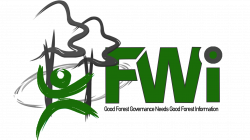Breaking Information Asymmetry to Save the Remaining Natural Forests in West Papua Province.
The State of Papua Bioregion Forest
The Papua bioregion is a biogeographical imaginary line for the eastern region of Indonesia which lies in Sahul plain (Sahul land). This bioregion home to various unique flora and noteworthy fauna, including marsupial mammals such as kangaroos and birds endemic to Australia, indicating a remarkably high biodiversity. Such valuable biological assets are undoubtedly inseparable from the existence of natural forests which provide a habitat and food for them to live and reproduce. The very same importance of the forests also applies to human life.
The state of forests in the Papua Bioregion in 2000, 2009, 2013 and 2018 was recorded in a book that was launched by Forest Watch Indonesia (FWI) in 2019, entitled “the Papua Bioregion: Forests and People”. In 2018, natural forests in the region covered an area of 35.5 million hectares or around 81% of the total land area, which is approximately 40% of Indonesia’s remaining natural forest. Such is the importance of the Papua Bioregion as the last stronghold of Indonesia’s, and even the world’s, natural forests.
Periodically, FWI also collected deforestation data in the Papua Bioregion which was analysed from forest cover data in 2000, 2009, 2013 and 2018. The rate of deforestation in the 2000-2009 period in the Papua Bioregion area was reported to be 64,000 hectares/year. That rate was almost doubled in less than half-length period of 2009-2013 to 178,000 hectares/year, and further increased in 2013-2018 period to 184,000 hectares/year. With such accelerating rate of deforestation, during 2000-2018, Papua Bioregion has lost in total 2.2 million hectares of natural forests. Observing the accelerated (increasing rate) deforestation in the region, which was categorized as moderate rate on average, and looking back to what has happened to natural forests in Sumatera and Kalimantan islands, the deforestation rate in Papua Bioregion will unfortunately continue to a certain point.
FWI has reported that the destruction of Indonesian natural forests tended to move to eastern region, as those in the western and central region have been exhausted earlier. The rapid shift of natural forest destruction to eastward indicates massive forest and land control for corporate interests. Such condition has impaired the life of flora and fauna as well as the livelihood of local people who have been living and utilizing the forest according to their wisdom.
Transparency as a Principle for Improving Natural Resource Governance
FWI believes that appropriate natural resource governance requires reliable information resources. Transparency is a foremost requirement for the availability of quality information so as to enable participation, coordination, accountability and law enforcement as means of controlling the quality of performance in governance. In the absence of transparency, imbalance in the mastery of information and relevant factors between negotiating parties will occur, for instance, between policy makers and the affected parties. Such condition is known as information asymmetry.

Information asymmetry leads to a chaotic natural resource management. Actors, regulations, and natural resource management practices as components of changes to natural resource management are in poor quality. Concealment and inaccessible information prevent public to actively get involved in voicing their preferences and aspirations for a management action. These conditions of information asymmetry will lead to uncertain natural resource management situations, tenurial conflicts, rampant illegal logging practices, non-compliance with the law on forest and land use, and consequently incurring national losses. On the other hand, transparency will strengthen components of change and establish tenure certainty, appropriate forest management and land use, and improve national revenue from the natural resources sector. Therefore, it is clear that transparency is the principal means to achieve fair and sustainable management of natural resources.

We have observed and recorded several irregularities in the management of closed natural resources [1]:
First, the official statistics on timber production and forest conversion did not record all of the timber that is actually logged. According to them, total commercial timber production from natural forests in Indonesia during 2003–2014 was 143.7 million m3. Meanwhile, the results of a KPK study in 2015 revealed that the actual total timber production during the that period has reached 630.1 to 772.8 million m3. These figures indicate that statistics from the Ministry of Environment and Forestry recorded only 19–23% of total timber production during this period. As a result, the domestic commercial value for unrecorded timber production has caused Indonesia to suffer a loss of IDR 598.0 to 799.3 trillion, or IDR. 49.8 – 66.6 trillion per year.
Second, the mining industry in Indonesia has been developed and thriving, both in terms of the area of handed-over mining concessions and the production rated of mined raw materials. A closer look at the permits that have been granted to mining companies revealed that as of April 2014, of the hundreds of existing mining permits (izin usaha pertambangan, IUP) throughout Indonesia, there were 7,468 IUPs covering an area of 34.72 million hectares, which 25.98 million hectares of them were located in the forest areas. Even the latest data stated that there was a significant increase in issued IUPs. During this period, mining permits has reached 10,827 IUPs, and 57.85 percent of them did not meet the clean and clear criteria. This record, once again, indicates that Indonesia has suffered unaccounted national loss.
Third, the expansion of oil palm plantations also contributed to forest destruction. During 2010-2013, there was at least 579,000 hectares of forest area being released for plantations, mostly in Kalimantan, with 195,000 hectares. According to the records of the West Kalimantan Civil Society Coalition (2015), the potential national loss for the plantation sector in West Kalimantan Province alone was estimated at IDR 4.1 trillion, which was due to the underhand practices involved in granting plantation permits.
Fourth, the high rate of natural resources destruction has harmed indigenous people, local communities, and biodiversity. Harm to these capitals often goes hand in hand with social and tenure conflicts. The high number of natural resource conflict cases is suspected due to the increasing number of permit holders for large-scale management in an area which has denied the community access to forests. Large-scale extractive companies almost always justified any means to obtain land tenure, including bribery and corruption, and even more worrisome was through the practice of splitting and creating frictions between community groups.
Improvement of Public Information Disclosure Law Implementation
Information Disclosure is part of the citizens’ right to know about relevant information that affects the lives of many, as well as encouraging community involvement in the policy-making process. In the Information Disclosure Law No. 14 of 2008, Public Information Disclosure mainstreaming aims to:
a. guarantees the rights of citizens to know the plans for making public policies, public policy programs, and the process of making public decisions, as well as the reasons for making a public decision;
b. encourage public participation in the public policy-making process;
c. increase the active role of the community in public policy making and proper management of Public Agencies;
d. realise proper state administration, namely one that is transparent, effective and efficient, and accountable;
e. make aware of the reasons for public policies that affect the lives of many people;
f. develop science and educate the nation; and/or
g. improve the information management and service within the Public Agency to achieve quality information services.
Several things were highlighted by FWI in initiating the mainstreaming of public information disclosure in Papua by using 5 indicators, as follows;
1. Announcement Public Information in accordance with Article 9 of the KIP Law, Article 11 Perki SLIP;
2. Providing Public Information in accordance with Articles 11, 14, and 15 of the KIP Law, Article 13 Perki SLIP;
3. Public Information Request Service in accordance with Articles 7 and 12 of the KIP Law, Articles 4, 8 and 9 of Perki SLIP;
4. Management of Information and Documentation in accordance with Article 13 of UU KIP, Article Perki SLIP;
5. Commitment, Coordination and Innovation of Public Agencies according to Central Information Commission Decree No. 3 of 2018.
FWI has started by approaching and assisting one of the OPDs in West Papua Province, namely the OPD of the Tambrauw Regency Environmental Service. West Papua was selected because it had the lowest Public Information Openness Index in Indonesia. Tambrauw Regency was chosen because it was a newly split district in accordance with the mandate of Law no. 56 of 2008 on the Establishment of Tambrauw Regency in West Papua Province, which in 2022 would move the Regency Capital from Sausapor to Fef. The steps to determine issues that require improvement of Public Information Disclosure are as follows:
a. Discussions and interviews on the 5 indicators of Public Information Disclosure. Two series of each were conducted remotely/online. These discussions formulated the needs of the Tambrauw Regency DLH OPD on the substance that is the mandate of the UU KIP.
b. Self-assessment of KIP performance by OPD DLH Tambrauw Regency.
FWI and OPD DLH Tambrauw Regency, then followed up by agreeing to carry out improvements through assistance, facilitation, and training in mainstreaming public information disclosure. Here are some things that have been resolved together:
a. Period 9-20 August 2020
o Brainstorming Duties & Functions of DLH (Explanation of Strategic Plan 2023-2027)
o Brainstorming the urgency of KIP in DLH & other OPD (PMPTSP Office)
o Identification of Public Information List (DIP)
o Creating social media as a channel for public agency information (FB & IG)
b. Period 9-18 September 2022
o Agreeing on DIP and File Management
o Understanding Document Supporting Actor Map
o Agreeing on the Flow of Information Services
o Appointing PPID Administrator
o Connecting DLH Tambrauw with Provincial Ministry of Information as a link/line of coordination and advice
c. Periode 14-16 September 2022: Approaching West Papua Provincial Government (OPD Department of Communication and Information, Coding and Statistics)
o Coordinating with the Provincial Ministry of Information to encourage KIP in all agencies. This includes PPIDs at all district and provincial levels, and the PPID website.
o Asking for instruction from the Provincial Ministry of Information to strengthen KIP in Tambrauw.
o Initiating KIP Mainstreaming in West Papua and Tambrauw.
FWI as a civil society organization is committed to keep encouraging the implementation of Public Information Disclosure in Provincial Governments of Papua, West Papua, Central Papua, Papua Highlands, South Papua and the Aru Islands, to save natural forests and the people of Papua Bioregion.
Policy Brief. Initiation of Information Disclosure of Natural Resources in the Forestry Sector: The Importance of the Role of Cross-Sectoral Ministries/Institutions. Forest Management Working Group. 2015.



